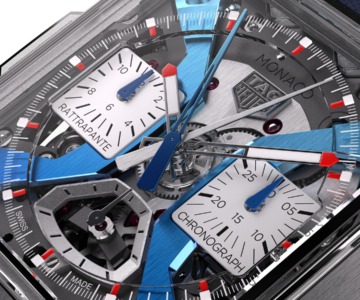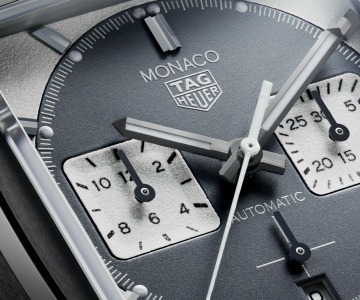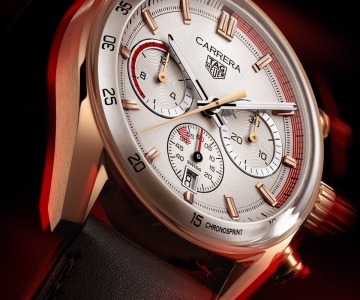 Depuis ses débuts cinématographiques sur le poignet de Stevemythique qui marqua l’esprit de toute une époque et changea à jamais la face de l’horlogerie suisse de luxe, n’a pas pris une ride.
Depuis ses débuts cinématographiques sur le poignet de Stevemythique qui marqua l’esprit de toute une époque et changea à jamais la face de l’horlogerie suisse de luxe, n’a pas pris une ride.
La Monaco : Avant-garde et performance dans un format carré
Lancée simultanément à Genève et New York le 3 mars 1969, la Monaco fut comme un ouragan dans l’univers de l’horlogerie. L’aspect provocateur de la montre, avec sa trotteuse rouge vif, son cadran bleu métallique, son verre bombé et son grand boîtier taillé à angles droits, rompait totalement avec les codes esthétiques de l’horlogerie traditionnelle. Tout aussi novatrice, sa technologie offrait une parfaite étanchéité, une grande première pour une montre carrée. Mais la révolution reposait essentiellement dans le cœur de la montre : le célèbre Chronomatic Calibre 11, le premier mouvement automatique de chronographe à microrotor, si précis qu’il reste encore aujourd’hui à la pointe des instruments chronométriques professionnels.
 Pour Le Mans, Steve McQueen s’inspira de son ami Jo Siffert, le célèbre pilote suisse qui, en 1969, devint le premier coureur automobile à être sponsorisé par une marque de montre, Heuer. La Monaco Heuer venait de sortir et impressionna tellement McQueen qu’il insista pour la porter dans le film. La Monaco devint alors le chronographe préféré de l’univers de la course automobile et de la mode – encore une première mondiale. Sa géométrie si particulière initia la vogue des montres « à forme ». Instantanément identifiable, souvent copiée mais jamais égalée, la « McQueen Monaco » (modèle 1133B) est l’une des montres les plus convoitées sur le marché international des pièces d’occasion. La demande est bien supérieure à l’offre : il n’en resterait plus que quelques-unes, toutes dans les mains de collectionneurs avertis.
Pour Le Mans, Steve McQueen s’inspira de son ami Jo Siffert, le célèbre pilote suisse qui, en 1969, devint le premier coureur automobile à être sponsorisé par une marque de montre, Heuer. La Monaco Heuer venait de sortir et impressionna tellement McQueen qu’il insista pour la porter dans le film. La Monaco devint alors le chronographe préféré de l’univers de la course automobile et de la mode – encore une première mondiale. Sa géométrie si particulière initia la vogue des montres « à forme ». Instantanément identifiable, souvent copiée mais jamais égalée, la « McQueen Monaco » (modèle 1133B) est l’une des montres les plus convoitées sur le marché international des pièces d’occasion. La demande est bien supérieure à l’offre : il n’en resterait plus que quelques-unes, toutes dans les mains de collectionneurs avertis.
Depuis lors, le cadran carré de la Monaco n’a cessé d’incarner l’esthétique novatrice de TAG Heuer. Rééditée en 1998 en série limitée à 5 000 exemplaires, elle fut entièrement redessinée en 2003, et dotée d’un bracelet d’acier à sept rangs de maillons carrés, rappelant l’audacieuse géométrie du boîtier. La montre est devenue un must chez les amateurs de course automobile et les collectionneurs, mais, contre toute attente, a également percé Hollywood et le monde de la haute couture en s’imposant comme un incontournable accessoire de mode.
Les réinterprétations qui ont suivi ont été encore plus révolutionnaires.
La Monaco Sixty Nine
Star de Baselworld 2003, la Concept Watch Monaco Sixty Nine de TAG Heuer fut présentée comme la première montre mécanique suisse dotée d’un chronographe au 1/1 000e. Cette montre à cadran mécanique/numérique réversible, unique en son genre, est une pièce audacieuse qui combine tradition et innovation d’une façon tout à fait inédite. D’un côté, le format culte et intransigeant de la montre préférée de Steve McQueen ; de l’autre, la haute technologie numérique du Microtimer, premier chronographe suisse offrant une précision au 1/1 000e de seconde. Deux montres TAG Heuer – une pour la précision, l’autre pour l’esprit vintage – réunies en une seule.
La Monaco V4
 Présentée à Baselworld 2004, la Monaco V4 constitue une véritable révolution technologique. Elle abrite un mouvement mécanique intégré de pointe, inséré à l’envers dans un boîtier carré s’inspirant de la Monaco classique. Le nom V4 procède des quatre barillets du mouvement, montés en V, tels les cylindres d’un moteur de Formule 1 suralimenté. Le nom rend également hommage à l’univers dont la montre s’est inspirée : bien que bénéficiant des derniers concepts de la technologie industrielle, sa véritable muse, à l’instar de la toute première Monaco, est le monde des sports mécaniques en général et des voitures de course en particulier.
Présentée à Baselworld 2004, la Monaco V4 constitue une véritable révolution technologique. Elle abrite un mouvement mécanique intégré de pointe, inséré à l’envers dans un boîtier carré s’inspirant de la Monaco classique. Le nom V4 procède des quatre barillets du mouvement, montés en V, tels les cylindres d’un moteur de Formule 1 suralimenté. Le nom rend également hommage à l’univers dont la montre s’est inspirée : bien que bénéficiant des derniers concepts de la technologie industrielle, sa véritable muse, à l’instar de la toute première Monaco, est le monde des sports mécaniques en général et des voitures de course en particulier.
La Monaco Grande Date
Celle-ci vient compléter la gamme des montres culte, avec un boîtier en acier poli de 37 mm, un mouvement TAG Heuer Grande Date, deux écrans noir et bleu/argent avec un petit compteur secondaire à 6h et des aiguilles losange à pointes superluminova, le tout sous un verre en saphir bombé. Avec son bracelet alligator et ses lignes architecturales épurées rappelant le boîtier de la Monaco V4, cette montre allie élégance et modernité.
Tous les attributs de la Monaco sont réunis, mais adoucis par le charme du cuir blanc, ou du python brun ou noir. Les vingt-six diamants du boîtier font ressortir les angles droits de la lunette, et le cadran s’orne lui aussi de treize diamants. La montre a autant de caractère que l’originale, mais ses harmonies de ton, de matière et de texture renforcent incontestablement sa force émotionnelle.
La Monaco Classic Chronograph
Pour célébrer le 40e anniversaire de la Monaco, TAG Heuer a l’honneur de présenter une nouvelle collection de Classic Chronograph dotées du mouvement automatique « Calibre 12 ». S’inspirant directement du design original, ces chronographes s’ornent d’un verre en saphir et d’un boîtier qui laisse voir les rouages du mouvement.
Parmi les autres caractéristiques figurent un bracelet en alligator bleu foncé et un élégant cadran argent et bleu à aiguilles rouges. La configuration très tendance du cadran s’accorde parfaitement avec l’héritage emblématique de la gamme.
 La réédition originale de la TAG Heuer Monaco 1969
La réédition originale de la TAG Heuer Monaco 1969
1969-2009 : A l’ occasion de cet anniversaire historique, TAG Heuer a réédité le mythique cadran bleu en série limitée à 1 000 pièces, signées au dos par Jack Heuer et gravées en l’honneur de son ambassadeur, Steve McQueen. Équipée du mouvement Calibre 11, elle se dote également de poussoirs situés à 2 et 4 heures, d’une couronne à 9 heures, de compteurs à 9 et 3 heures, d’un guichet date à 6 heures (avec entourage appliqué main) et d’index des heures horizontaux diamantés.
After its scene-stealing debut on Steve McQueen’s wrist in Le Mans, the TAG Heuer Monaco, the square-cased icon of sporting glamour that captured the spirit of an era and changed forever the face of luxury Swiss watchmaking, remains as cool and cutting-edge as ever.
The Monaco: Avant-Garde Style and Performance, Squared
Launched simultaneously in Geneva and New York on March 3rd, 1969, the Monaco caught the watchmaking world by storm. The provocative look of the timepiece, with its fire-red chronograph hand, metallic blue dial, domed crystal, and big, squared-off case represented a complete break with the conventional codes of watch design aesthetics. Equally radical was the engineering required to ensure the chronograph’s perfect water-resistance — a world first for a square-shaped timepiece. But what was ticking inside was even more revolutionary: the famous self-winding Chronomatic “Calibre 11”, the first self-winding automatic chronograph movement with microrotor, so precise it rivals to this day the exacting standards of professional chronometer instruments.
For Le Mans, Steve McQueen’s source of inspiration was his friend, Jo Siffert, the Swiss racecar legend who in 1969 became the first-ever driver sponsored by a watch brand, Heuer. The Heuer Monaco had just been launched and so impressed McQueen that he insisted on wearing it in the film. The Monaco became the preferred chronograph of the racing and fashion world — another world first. Its unique, uncompromising geometry started a trend toward “shaped” watches. Instantly recognizable, often copied, never equaled, the “McQueen Monaco” (Model 1133B) is one of the most highly prized pieces in the international vintage markets. Demand far exceeds supply — only a handful is known to still exist, all in the hands of well-informed collectors.
Ever since, the Monaco’s emblematic square-shaped dial has been synonymous with TAG Heuer’s innovative aesthetic. Reissued in 1998 in a limited edition of 5,000, it was entirely redesigned in 2003, refitted with a 7-row steel bracelet of square links echoing the daring aesthetics of the case. The watch became a must-have among racing purists and collectors, but it also surprised the industry by becoming the huge breakout fashion hit of the year, adored by haute couture and Hollywood.
The re-interpretations that followed were even more revolutionary.
THE MONACO SIXTY-NINE
The star of Baselworld 2003, the TAG Heuer Monaco Sixty Nine Concept Watch, was presented as the first Swiss wrist-worn mechanical watch combined with a 1/1000th of a second chronograph. The brand’s first reversible, mechanical/digital watch is a daring timepiece that brings together traditional and cutting-edge in a way never seen before. On one side, the iconic, uncompromising face of Steve McQueen’s favourite watch; on the other, the distinctive, high-tech digital face of the Microtimer, the first prestigious Swiss wrist -worn chronograph accurate to 1/1000th of a second. Two TAG Heuer watches-one for ultimate precision, the other for unmatchable Steve McQueen-vintage flair -in one extraordinary wristwatch.
THE MONACO V4
Presented during Baselworld 2004, the Monaco V4 represents a stunning technological breakthrough. At its heart is an advanced integrated mechanical movement, encased upside down in a high-design evolution of the classic square-faced Monaco. The name V4 derives from the movement’s four barrels, which are mounted in a V shape, like cylinders in a supercharged motor-racing engine. The name also pays tribute to the movement’s inspiration: while the V4 draws from the newest concepts in industrial technology, its true muse, like the original Monaco’s, is the world of high-tech, high-performance racecar engines.
THE MONACO WATCH GRANDE DATE
The next addition to the must-have line, with a 37mm polished stainless steel case, TAG Heuer Grande Date movement, two dials in black and blue/silver, with a small second counter at 6 o’clock and diamond-shaped hands tipped in superluminova, all under curved sapphire crystal. Compellingly designed and crafted, with its elegant alligator strap and clean, architectural lines inspired by the Monaco V4 case, this watch is resolutely modern.
All the classic Monaco attributes are there but softened by the charm of white leather, or brown or black python. The case is set off by 26 diamonds accentuating the bezel’s right angles, and the dial with a further 13 diamonds. As energetic as the original but with exquisite harmonies of tone, material, and texture for further heighten the emotive force.
THE MONACO CLASSIC CHRONOGRAPH
To celebrate the MONACO’s 40th anniversary, TAG Heuer is proud to present a new collection of Classic Chronograph fitted with a TAG Heuer “Calibre 12” automatic movement, heritage of the original “Calibre 11”.
Directly inspired by the original design, these chronographs adorn a sapphire crystal glass and a case back allowed to see the beat of the “Caliber 12”.
Standout features include a dark blue alligator strap and stylish silver and blue dial with red hands. The new, fashion-forward animation on the chronograph dial is completely in line with the line’s iconic heritage.
THE TAG HEUER MONACO 1969 ORIGINAL RE-EDITION
1969-2009: To commemorate this historic anniversary, TAG Heuer has proudly republished this iconic blue-dial timepiece in a limited series of 1,000 pieces with an exclusive case back signed by Jack Heuer and engraved in honour of its mythical ambassador Steve McQueen. Outfitted with the Calibre 11 movement, its other classic features include pushbuttons at 2 and 4 o’clock, crown at 9, counters at 9 and 3, hand-applied date window at 6 o’clock, and diamond-tipped horizontal hours indexes.
sources : www.tagheuer.com




superbe